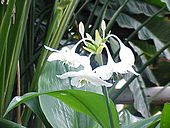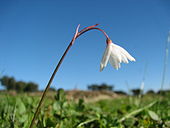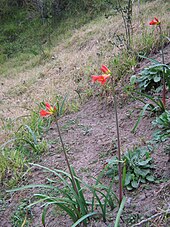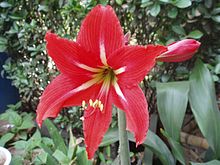Amaryllidoideae
| Amaryllidoideae | ||||||||||||
|---|---|---|---|---|---|---|---|---|---|---|---|---|

Belladonna Lily ( Amaryllis belladonna ) |
||||||||||||
| Systematics | ||||||||||||
|
||||||||||||
| Scientific name | ||||||||||||
| Amaryllidoideae | ||||||||||||
| Burnett |
The subfamily Amaryllidoideae belongs to the plant family of the Amaryllis family (Amaryllidaceae) within the order of the asparagus-like (Asparagales). It includes (depending on your perspective) between 59 and 67 genera and more than 800 species , which occur particularly in warmer areas and have an almost worldwide distribution. With around 100 endemic species, the Amaryllidoideae are an important floral element of the Capensis . The name of the eponymous genus Amaryllis is derived from the name of a shepherdess from the Eclogae Virgils . Many species and their varieties are used as ornamental plants in parks, gardens and spaces.
description

Vegetative characteristics
They are perennial herbaceous plants . They are rarely evergreen. Usually these geophytes form bulbs , or sometimes rhizomes (only in Clivia , Cryptostephanus and Scadoxus ), as persistence organs. The bulbs or rhizomes are held at the same depth in the ground by special pulling roots that lengthen or shorten through contraction.
The alternate, spiral or two-line arranged leaves are basal or distributed on the stem. The parallel-veined leaves are stalked or sessile. The simple leaf blade linear or lanceolate. The leaf surfaces are mostly smooth, but in the semi-arid areas of southern Africa the leaf surfaces of Brunsvigia , Crossyne , Gethyllis and Haemanthus species are covered with hairs of different shapes ( trichomes ). The leaves of Crossyne - and some Haemanthus - have attractive dark green or red spots on the leaves. The leaf margin is smooth.
Inflorescences and flowers
There is a more or less long, leafless inflorescence stem. The flowers are singly or usually a few to many together in zymose , dold-like or capitate inflorescences . There are usually two, rarely up to eight bracts present; they can be free or overgrown. There are often more or less long flower stalks.
The hermaphrodite, threefold flowers are radial symmetry or zygomorphic . The six bracts are designed the same ( tepals , perigone ); they are free or overgrown. The bracts can be green to white, cream to yellow, red to pink to purple or brown in different combinations, rarely (only in Griffenia , Worsleya and Lycoris ) they are bluish, but not pure blue. There may be a cup-shaped secondary crown (for example, narcissus ). There are almost always two, very rarely only one or more, circles with three stamens each; they are free or fused with one another, they can also be fused with the bloom cladding sheets. Some Griffenia species have five and some Gethyllis species have up to 60 stamens. The stamens are mostly free, but in Pancratium and Hymenocallis grown together cup-shaped over almost their entire length. The three pistils have become an under constant (rare half under permanent) syncarp ovary grown. There are one or three styluses that end in a cephalic or three-lobed stigma. The nectar secretion occurs depending on the tribe through the bracts (Galanthieae) or septal nectaries of the ovary. Often the flowers have a strong scent.
Fruits and seeds
Mostly triple capsule fruits are formed or only berries are formed in the African tribe Gethyllideae and Haemantheae . The winged or wingless seeds are mostly flat and black due to phytomelans or rarely fleshy, rounded and green or red. The seeds contain oils but no starch.
Chromosomes and ingredients
The most common chromosome base number is x = 11, n = 5-12 or more. The chromosomes are (rarely 1.5 to) 3 to 28 µm long.
Characteristic ingredients are phenanthridine alkaloids .
Occurrence
Species of the Amaryllidoideae are distributed from the temperate over the subtropical to the tropical areas of the world. Centers of diversity are South America with around 28 genera and the Capensis with around 18 genera . Although the Mediterranean region is the origin of many ornamental plants, only eight genera are native there. There are only three genera in Australia. In Southern Africa 210 species are endemic. Namaqualand and the Cape region are home to about 111 species, of which about 77% occur only there.
Species of the Amaryllidoideae thrive in many very different habitats , for example seasonally dry areas, ephemeral ponds, the herbaceous layer of rainforests as well as mixed forests and banks of rivers.













Systematics
The molecular genetic investigations in the last ten years have led to the fact that the family boundaries within the order of the Asparagales have shifted significantly. The systematics of this subfamily, earlier family, has been discussed for a long time. Subfamilies and tribes were set up and discarded again, so one will often come across seeming inconsistencies in literature. The systematics according to Mark W. Chase et al. 2009. The Amaryllidaceae Family J.St.-Hil. has been greatly expanded. The tribe of the previous Amaryllidaceae remain unchanged only one rank lower in a subfamily Amaryllidoideae Burnett.
The subfamily Amaryllidoideae was first published in 1835 under the name "Amaryllidae" by Gilbert Thomas Burnett in Outlines of Botany , p. 446. Type genus is Amaryllis L. Synonyms for Amaryllidoideae Burnett are: Brunsvigiaceae Horan. , Cyrtanthaceae Salisb. , Galanthaceae G.Mey. , Gethyllidaceae Raf. , Haemanthaceae Salisb. , Leucojaceae Batsch ex Borkh. , Oporanthaceae Salisb. , Pancratiaceae Horan. , Strumariaceae Salisb. , Zephyranthaceae Salisb.
The subfamily Amaryllidoideae is divided into 14 tribes and comprises 59 to 70 genera with more than 800 species :
- Tribe Amaryllideae J.St.-Hil. : With bisulcate pollen. It contains about ten genera with about 146 species only in Africa . It is divided into four subtribes, here after the revision by Meerow 2001:
- Subtribus Amaryllidinae Pax in Engler & Prantl: It contains only one genus with only two species:
- Amaryllis L .: The only two species thrive in the winter rain areas of southern Africa .
- Subtribus Boophoninae D.Müll.-Doblies & U.Müll.-Doblies : It contains a genus with only two species:
- Subtribus Crininae Pax in Engler & Prantl: It contains about two genera with about 72 species in the tropics and sub-Saharan Africa:
- Ammocharis Herb. (Syn .: Cybztees ) Milne-Redhead & Schweickerdt : The seven or so species are common in Africa.
- Hook lilies ( Crinum L. ): The approximately 65 species are common in the tropics and subtropics.
- Subtribus Strumariinae Traub ex D.Müll.-Doblies & U.Müll.-Doblies : It contains about six genera with almost 100 species in Southern Africa:
- Brunsvigien ( Brunsvigia Heist. ): The 20 or so species are common in southern Africa.
- Crossyne Salisb. : It contains only two types, earlier in Boophone . They occur in the South African provinces of the Northern and Western Cape .
- Hessea Herb. (Syn .: Dewinterella D.Müll.-Doblies & U.Müll.-Doblies , Kamiesbergia Snijman ): The approximately 13 species are distributed in southern Africa.
- Namaquanula D.Müll.-Doblies & U.Müll.-Doblies : The only two species are common in southern Africa.
- Guernsey lilies ( Nerine Herb. ): The 25 to 30 species are common in southern Africa.
- Strumaria Jacq. ex Willd. (Syn .: Gemmaria Salisb. , Carpolyza Salisb. , Bokkeveldia D.Müll.-Doblies & U.Müll.-Doblies , Tedingea D.Müll.-Doblies & U.Müll.-Doblies ): The 24 to 28 species are in Southern Africa common.
- Subtribus Amaryllidinae Pax in Engler & Prantl: It contains only one genus with only two species:
- Tribus Calostemmateae D.Müll.-Doblies & U.Müll.-Doblies : It contains two genera with four species in Australasia :
- Calostemma R.Br. : The three or so species are common in Australia .
- Proiphys Herb. : The four species are common in Australia and Malesia .
- Tribus Clinantheae Meerow :
- Clinanthus Herb. : The approximately 35 species are distributed from Colombia to Chile .
- Pamianthe Stapf : The three or so species are common in Peru and Chile.
- Paramongaia Velarde : Of the only two species, one occurs only in Peru and one only in Chile.
- Tribe Cyrtantheae Salisb. : It contains only one genus:
- Cyrtanthus Aiton : The 55 or so species are distributed in Sub-Saharan Africa, mainly in the Capensis .
- Tribe Eucharideae (Pax) Hutchinson : The leaves are stalked. The stamens are often widened and fused or basal with appendages. The loculicidal capsule fruit contains large, fleshy seeds. It contains four genera with around 28 species in the Neotropic, especially in the Andes :
- Caliphuria Herb. : The four or so species are common in Colombia and Peru.
-
Eucharis Planch. & Linden : The approximately 17 species are common in the Neotropic, for example:
- Amazon lily ( Eucharis amazonica Linden ex Planchon )
-
Plagiolirion Baker : It contains only one species:
- Plagiolirion horsmannii Baker : It occurs only in western Colombia.
- Urceolina Rchb. (including Pseudourceolina Vargas ): The five or so species are common in Peru.
- Tribus Eustephieae (Pax) Hutchinson : It contains three to four genera with around 15 species in the Andes (Peru, Bolivia , Argentina ):
- Chlidanthus Herb. (Syn .: Castellanoa Traub ): The six or so species thrive in the Andes.
- Eustephia Cav. : The four or so species are distributed in the Andes, mainly Peru.
- Hieronymiella Pax : The five or so species are common in the Andes.
- Pyrolirion Herb. : The four or so species are common in the Andes.
- Tribus Galantheae Salisb. : The anthers open with pores. It contains five (to eight) genera with up to 31 species:
- Acis Salisb. : The approximately nine species are distributed in the western and western-central Mediterranean region.
- Snowdrop ( Galanthus L. ): It contains 17 to 20 species.
-
Hannonia Braun-Blanq. & Maire : It only contains one species:
- Hannonia hesperidum Braun-Blanquet & Maire: It occurs in Morocco .
-
Lapiedra Lag .: It contains only one species:
- Lapiedra martinezii Lag .: It is distributed from southeastern and southern Spain to Morocco.
- Knot flowers ( Leucojum L. ): Today it contains only two (previously ten) species from Europe to northern Iran .
- Tribe Haemantheae (Pax) Hutchinson : Berries are only produced in this tribe. Since Meerow 2004 it has been divided into three subtribes with six genera and about 80 species only in Africa:
- Subtribus Cliviinae D.Müll.-Doblies & U.Müll.-Doblies : They mainly thrive in summer rain areas of southern Africa. They form rhizomes as persistence organs. It contains two genera with about seven species:
- Klivien ( Clivia Lindl. ): The five or so species mostly thrive in summer rain areas, with the exception of Clivia mirabilis Rourke . They form rhizomes.
- Cryptostephanus Welw. ex Baker : The only two species thrive in summer rain areas. They form rhizomes.
- Subtribus Haemanthineae Pax : It contains two genera with about 29 to 34 species:
- Blood flowers ( Haemanthus L. ): The 20 to 22 species are common in southern Africa.
- Scadoxus Raf. : The nine to twelve species are distributed in sub-Saharan Africa.
- Subtribus Gethyllidinae (Dumort.) Meerow (Syn .: Tribus Gethyllideae Dumort. ): The individual flowers are only durable and the ovaries are below the soil surface. It contains two genera with about 41 species, which are mainly distributed in southern Africa:
- Apodolirion Baker : They mainly thrive in summer rain areas of southern Africa. There are two circles with three free stamens each and the stigmas are always clearly three-lobed. There are about six types.
- Gethyllis L .: They mainly thrive in winter rain areas of southern Africa. As a special feature within the monocotyledons there are more than 2 × 3 stamens in many species. There are around 35 types.
- Subtribus Cliviinae D.Müll.-Doblies & U.Müll.-Doblies : They mainly thrive in summer rain areas of southern Africa. They form rhizomes as persistence organs. It contains two genera with about seven species:
- Tribus Griffinieae Ravenna :
- It contains only one genus:
- Griffinia Ker Gawl. (Syn .: Hyline Herbert , Libonia Lem. ): The 15 to 20 species are common in Brazil.
- It contains only one genus:
- Tribus Hippeastreae (Pax & Hoffmann) Huchinson : The inflorescence shafts are hollow. The bracts are often fused together. The flowers are zygomorphic . The dry seeds are flattened. It contains 10 to 13 genera with 180 to 218 species in the Neotropic. There are two subtribes:
- Subtribus Traubiinae D.Müll.-Doblies & U.Müll.-Doblies : The basic chromosome number is always x = 8, polyploidy is rare and the scars are head-shaped. With around 20 species it contains around 10% of the species of the tribe, most species occur in Chile and Argentina:
- Phycella Lindl. (including Famatina Ravenna ): The more than seven species are common in Chile.
- Placea Miers : The three to five species are only common in central Chile.
- Rhodophiala C.Presl : The 30 to 40 species are in Chile, Argentina, Uruguay disseminated and Bolivia.
-
Traubia Moldenke : It contains only one species:
- Traubia modesta (Phil.) Ravenna : It occurs in Chile.
- Subtribus Hippeastrinae Walp. (Syn: Zephyranthinae Baker , Zephyranthaceae Salisb. , Zephyrantheae Hutch. , Sprekelieae Nakai , Habranthinae Traub , Tocantinieae Ravenna ): The basic chromosome numbers x = 6 to 11, polyploidy and aneuploidy are often up to briefly three-parted and the scars are mostly tripartite. It contains 90% of the species of the tribe. The species are common in the Neotropic:
- Eithea Ravenna : Only one or two species are common in Brazil .
- Habranthus Herb. (Syn .: Zephyranthella (Pax) Pax ): The approximately 50 species are common in the Neotropic.
- Rittersterne ( Hippeastrum Herb. , Syn .: Carlotea Arruda ex Koster , Leopoldia Herb. Nom. Rej., Callicore Link , Aulica Raf. , Eusarcops Raf. , Trisacarpis Raf. , Aschamia Salisb. , Chonais Salisb. , Lais Salisb. , Omphalissa Salisb. , Lepidopharynx Rusby , Moldenkea Traub ): The approximately 55 species are common in the Neotropic.
- Scallop lilies ( Sprekelia Heist. ): The roughly two species are common in Mexico and Guatemala .
- Zephyr flowers ( Zephyranthes Herb. , Syn .: × Cooperanthes Percy-Lanc. , Atamosco Adans. , Atamasco Raf. , Haylockia Herb. , Cooperia Herb. , Sceptranthes Graham , Mesochloa Raf. , Plectronema Raf. , Pogonema Raf. , Argyropsis M. Roem. , Arviela Salisb. , Aidema Ravenna ): It contains 50 to 70 species in the Neotropic.
- Subtribus Traubiinae D.Müll.-Doblies & U.Müll.-Doblies : The basic chromosome number is always x = 8, polyploidy is rare and the scars are head-shaped. With around 20 species it contains around 10% of the species of the tribe, most species occur in Chile and Argentina:
- Tribe Hymenocallideae (D.Müll.-Doblies & U.Müll.-Doblies) Meerow : It contains three genera with around 65 species in the New World:
- Fair skin ( Hymenocallis Salisb. ): The approximately 50 species are common in the Neotropic.
- Ismene Salisb. ex Herb. (including Elisena Herb. , Pseudostenomesson Velarde ): The eleven or so species are distributed in the Andes, mainly in Peru.
- Leptochiton Sealy : The only two species are common in Peru.
- Tribe Lycoridae Traub : It contains two genera with about 26 species in Asia :
- Spider Lilies ( Lycoris Herb. ): The 20 or so species are common in Asia.
- Ungernia Bunge : The six or so species are common in Central Asia.
- Tribus Narcisseae Endl. : Flowers mostly with a "secondary crown". It contains two genera with about 58 species in Europe to western Asia and northern Africa:
- Daffodils ( Narcissus L. ): The approximately 50 species (including Braxireon Raf. ) Are common in Europe.
-
Gold cups or storm flowers ( Sternbergia Waldst. & Kit. ): The eight or so species are mainly found in the northeastern Mediterranean , for example:
- Autumn gold cup ( Sternbergia lutea (L.) Ker-Gawler ex Sprengel )
- Tribe Pancratieae Salisb. : The bracts are fused tubular at their base. It contains two genera in the Old World :
- Tribe Stenomesseae Traub : The stamens are often fused into Staminalröhren. It contains about five (to eight) genera with about 62 species in the Neotropic, mainly in the Andes:
- Eucrosia Ker-Gawler : The eight or so species are common in Peru.
-
Mathieua Klotzsch : It only contains one species:
- Mathieua galanthoides Klotzsch : It is common in Peru.
- Phaedranassa Herb. : The roughly nine species distributed in the Neotropic.
- Rauhia grape : the four or so species are common in northern Peru.
- Stenomesson Herb. : The 20 to 35 species are common in Peru.
- Not classified in a tribe ( incertae sedis ) is:
-
Worsleya (W. Watson ex Traub) Traub : It contains only one species:
- Worsleya procera (Lemaire) Traub : It is endemic to the Organ Mountains in the Brazilian state of Rio de Janeiro .
-
Worsleya (W. Watson ex Traub) Traub : It contains only one species:
There are some generic hybrids (selection):
- × Amarcrinum Coutts = Amaryllis × Crinum
- × Amarine Sealy = Amaryllis × Nerine
- × Amaristes Hannibal = Amaryllis × Cybierteres
- × Amarygia Cif. & Giac. = × Brunsdonna Tubergen ex Worsley = Amaryllis × Brunsvigia
- × Hippeastrelia = Hippeastrum × Sprekelia
- × Urceocharis Masters = Urceolina × Eucharis
Cladogram
Cladogram according to Meerow 2006:
|
|
|
|||||||||||||||||||||||||||||||||||||||||||||||||||||||||||||||||||||||||||||||||||||||||||||||||||||||||||||||
|
|
use

There are varieties of many species in the amaryllis family that are used worldwide as ornamental plants in parks, gardens and in rooms and as cut flowers . As cut flowers, for example, uses nerines ( Nerine ) and amaryllis ( Hippeastrum ). In the temperate latitudes, for example, knot flowers ( Leucojum ), snowdrops ( Galanthus ) and daffodils ( Narcissus ) are used in parks and gardens. In warm temperate and subtropical areas, species and varieties from the genera Amaryllis , Clivia , Hippeastrum, Nerine and Zephyranthes are most commonly used in parks and gardens. As houseplants are Klivie ( Clivia miniata ), the amaryllis ( Hippeastrum ) and rarely haemanthus ( Haemanthus ) used.
Many types are used in traditional folk medicine . Africans used the onions and leaves as compresses and decoctions to treat inflammation and digestive disorders, but in higher doses they are extremely toxic. The South African Zulu used the Clivia rhizomes as a protective spell.
Cultural history
In Peru, the Inca decorated ceremonial drinking vessels with images of Amaryllidaceae flowers ( Ismene , Pyolirion and Stenomesson ). In southern Africa, indigenous peoples rarely depicted plants; the only rock painting of a Brunsvigia -Art in Lesotho perhaps illustrates the importance of the San people of the psychoactive effects were their onions.
supporting documents
- Mark W. Chase, James L. Reveal & Michael F. Fay: A subfamilial classification for the expanded asparagalean families Amaryllidaceae, Asparagaceae and Xanthorrhoeaceae. In: Botanical Journal of the Linnean Society , Volume 161, Issue 2, 2009, pp. 132-136. (Section systematics)
- The Amaryllidaceae family on the AP website. (Section Systematics) To edit the article last used in January 2009
- The family of Amaryllidaceae s. st. at DELTA by L. Watson and MJ Dallwitz. (Section Description) To edit the article last used in January 2009
- Alan W. Meerow: Neotropical Amaryllidaceae at Neotropikey by Royal Botanical Gardens, Kew.
- Systematics and further information on the family Amaryllidaceae s. st. within the subfamily Amaryllidoideae. (French)
- WS Judd, CS Campbell, EA Kellogg, PF Stevens & MJ Donoghue: Amaryllidaceae , In: Plant Systematics: A Phylogenetic Approach , 3rd Edition, Sunderland, Massachusetts, 2007, pp. 270-272, ISBN 978-0-87893-407 -2 .
- Alan W. Meerow & Deirdre A. Snijman: The never-ending story: multigene approaches to the phylogeny of amaryllidaceae , In: Aliso , Volume 22, 2006, pp. 355–366: PDF ( Memento of March 3, 2012 in the Internet Archive ).
- Dee Snijman, May 2004: The Amaryllidaceae s family. st. to the extent of the subfamily Amaryllidoideae at PlantZAfrica from the South African National Biodiversity Institute = SANBI.
- Alan W. Meerow & Deirdre A. Snijman: Phylogeny of Amaryllidaceae Tribe Amaryllideae Based on nrDNA ITS Sequences and Morphology , In: American Journal of Botany , Volume 88 (12), 2001, pp. 2321-2330.
- Zhanhe Ji & Alan W. Meerow: Amaryllidaceae , pp. 260–265 - the same text online as the printed work , In: Wu Zheng-yi, Peter H. Raven (Ed.): Flora of China , Volume 24 - Flagellariaceae through Marantaceae , Science Press u. a., Beijing and St. Louis, 2000, ISBN 0-915279-83-5 .
- Alan W. Meerow, Mark W. Chase, Charles L. Guy, Q.-B. Li, Deirdre A. Snijman & Si-Ling Yang: Phylogeny of Amaryllidaceae: molecules and morphology. Pp. 368-382 in K. Wilson & D. Morrison (Eds.): Monocots, systematics and evolution , CSIRO Press, Sydney 2000.
- Alan W. Meerow, Charles L. Guy, QB. Li & Si-Ling Yang: Phylogeny of neotropical Amaryllidaceae based on nrDNA ITS sequences. , in Systematic Botany , Volume 25, Issue 4, 2000, pp. 708-726 ( DOI: 10.1007 / s00606-003-0085-z ).
- Alan W. Meerow, Michael F. Fay, Charles L. Guy, Q.-B. Li, FQ Zaman & Mark W. Chase: Systematic of Amaryllidaceae based on cladistic analysis of Plastid RBCL and TML-F sewuences of data. , In: American Journal of Botany , Volume 86, 1999, pp. 1325-1345.
Individual evidence
- ↑ a b c d e f g h i j k l m n o Dee Snijman, May 2004: The Amaryllidaceae family s. st. to the extent of the subfamily Amaryllidoideae at PlantZAfrica from the South African National Biodiversity Institute = SANBI.
- ↑ Angiosperm Phylogeny Group: An update of the Angiosperm Phylogeny Group classification for the orders and families of flowering plants: APG III , In: Botanical Journal of the Linnean Society , Volume 161, Issue 2, 2009, pp. 105-121
- ↑ Mark W. Chase, James L. Reveal & Michael F. Fay: A subfamilial classification for the expanded asparagalean families Amaryllidaceae, Asparagaceae and Xanthorrhoeaceae , in Botanical Journal of the Linnean Society , Volume 161, Issue 2, 2009, p. 132– 136.
- ↑ Entry in Tropicos .
- ↑ Amaryllidoideae in the Germplasm Resources Information Network (GRIN), USDA , ARS , National Genetic Resources Program. National Germplasm Resources Laboratory, Beltsville, Maryland.
- ↑ Rafaël Govaerts (Ed.): Enter taxon in search mask at World Checklist of Selected Plant Families of the Board of Trustees of the Royal Botanic Gardens, Kew .
- ↑ Alan W. Meerow, Charles L. Guy, QB. Li & Si-Ling Yang: Phylogeny of neotropical Amaryllidaceae based on nrDNA ITS sequences. , in Systematic Botany , Volume 25, Issue 4, 2000, pp. 708-726: PDF .
- ↑ a b c d Alan W. Meerow & Jason R. Clayton: Generic relationships among the baccate-fruited Amaryllidaceae (tribe Haemantheae) inferred from plastid and nuclear non-coding DNA sequences , in Plant Systematics and Evolution , Volume 244, Numbers 3– 4, 2004, pp. 141–155 ( doi: 10.1007 / s00606-003-0085-z ) PDF .
- ↑ Nicolás García, Alan W. Meerow, Douglas E. Soltis, Pamela S. Soltis: Testing Deep Reticulate Evolution in Amaryllidaceae Tribe Hippeastreae (Asparagales) with ITS and Chloroplast Sequence Data In: Systematic Botany , Volume 39, Issue 1, 2014, p 75-89. doi : 10.1600 / 036364414X678099
Web links
- Cultural history of the amaryllis family (PDF, 890 kB)
- Alan W. Meerow, Javier Francisco-Ortega, David N. Kuhn & Raymond J. Schnell: Phylogenetic Relationships and Biogeography within the Eurasian Clade of Amaryllidaceae Based on Plastid ndhF and nrDNA ITS Sequences: Lineage Sorting in a Reticulate Area? , In: Systematic Botany , Volume 31, Issue 1, 2006, pp. 42-60: PDF .
